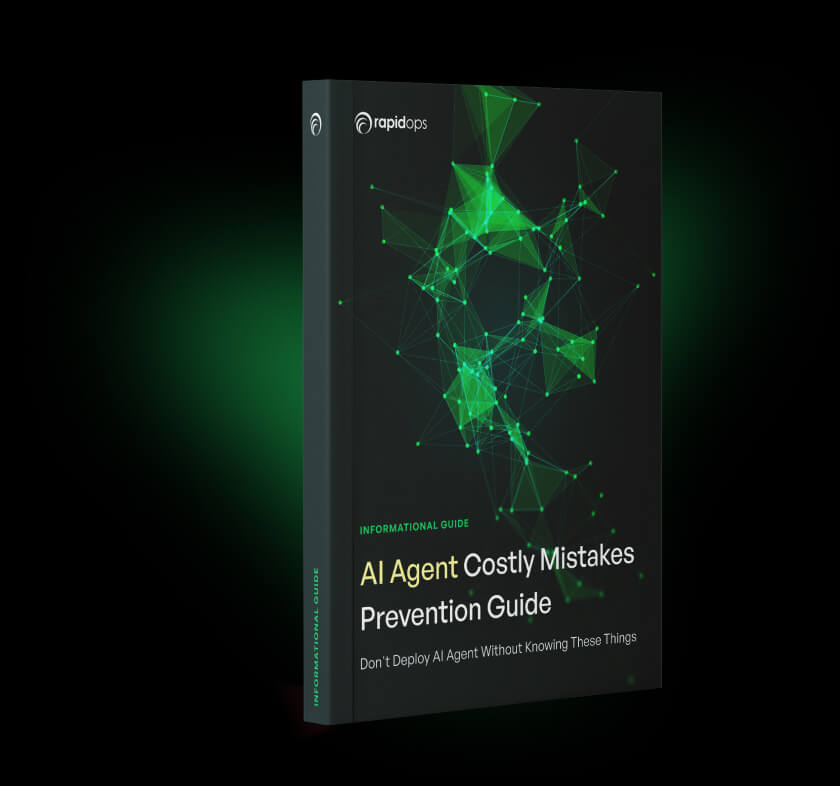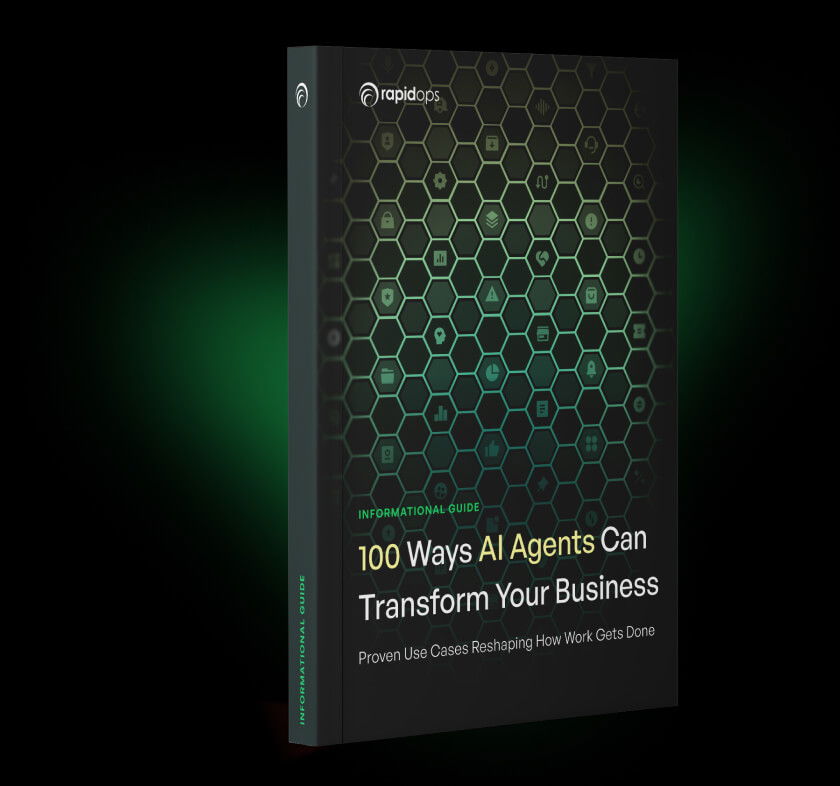You already know that large language models (LLMs) are reshaping how organizations think, operate, and compete, but their real impact is only just beginning. In 2026, their potential goes far beyond automation or content generation. Large language models are rapidly evolving into strategic engines that drive innovation, unlock hidden insights, and power smarter, faster decisions across every corner of an organization. They are enabling businesses to work not just more efficiently, but more intelligently, turning knowledge, data, and processes into real competitive advantage.
Across industries, companies are already seeing measurable results. LLMs are streamlining operations, surfacing actionable insights from mountains of unstructured data, and scaling knowledge to work without increasing headcount or requiring massive AI infrastructure. The next wave promises even greater impact: predictive trend analysis, hyper-personalized customer experiences, real-time strategic decisions, and the ability to anticipate market shifts before competitors can react.
What makes LLMs truly transformative is how they directly address the pressing challenges that hold businesses back today. Fragmented information no longer clouds decision-making; operational bottlenecks are minimized, and innovation pressure is managed with intelligence-driven processes, all while remaining practical and accessible to teams of any size. Even lean organizations can leverage LLMs to create tangible, measurable value, turning complexity into clarity, insights into action, and strategy into results.
If you’re exploring how to make your business more efficient, resilient, and future-ready, this blog will help you understand the role LLMs can play in 2026 and the opportunities they unlock.
What are large language models (LLMs)
Large language models (LLMs) are a class of foundation models designed to understand, generate, and interact with human language at scale. Trained on vast and diverse datasets spanning documents, code, transcripts, and more, LLMs use transformer-based architectures to capture the nuances of language, context, and meaning with remarkable depth and flexibility.
At their core, LLMs represent a significant leap in natural language processing. Unlike traditional rule-based systems or task-specific models, LLMs are built to generalize across use cases. They can generate coherent narratives, summarize complex content, answer domain-specific questions, translate between languages, and support intelligent dialogue, all from a single, unified model architecture that powers everything from AI agent development to generative AI software development.
This versatility is enabled by billions of parameters and advanced learning techniques, such as self-attention, which allow LLMs to infer relationships within text, retain contextual awareness, and produce relevant responses in real time. Importantly, LLMs are not static; they can be further refined on enterprise-specific data to align with brand voice, regulatory needs, and domain knowledge, a process known as LLM fine-tuning.
As enterprises scale their adoption of AI, LLMs are emerging as foundational assets that power intelligent automation, enhance decision-making, and transform how people interact with systems, data, and one another.
Don't think of deploying AI agents without knowing these key factors that drive success & prevent costly mistakes
Download Now
Top 5 large language model use cases in 2026
The real power of LLMs in 2026 lies not in their technical novelty but in their ability to drive purposeful transformation where it matters most, across customer-facing functions, knowledge ecosystems, and operational decision-making. What distinguishes this phase of adoption is the shift from isolated pilots to deeply integrated, business-aligned implementations that solve longstanding challenges with clarity, scale, and speed.
Each demonstrates how LLMs are enabling breakthroughs that once felt out of reach, from processing massive unstructured data in seconds to powering real-time decisions and experiences that traditional systems simply couldn’t achieve.
1. LLM-powered content generation at scale
In 2026, content is no longer just a deliverable; it is a strategic driver of growth, customer engagement, and operational efficiency. Enterprises today face unprecedented pressure to produce content at scale: marketing campaigns, e-commerce product descriptions, knowledge base articles, regulatory documentation, internal policies, and support materials must all be accurate, compliant, and tailored to diverse audiences. Traditional content operations, reliant on manual processes and siloed workflows, cannot keep up with this velocity or complexity.
Large language models (LLMs) are transforming this landscape, enabling LLM-powered content generation at scale. By leveraging generative AI, enterprises can create high-quality, context-aware content for diverse purposes: marketing copy, onboarding materials, technical documentation, legal drafts, product attribute extraction, and customer-facing support content. These models maintain tone consistency, brand alignment, and compliance while freeing human teams from repetitive administrative tasks and content bottlenecks.
When integrated into enterprise systems such as CMS, DAM, and localization workflows, LLMs enable real-time content delivery across geographies, business units, and customer segments, improving efficiency and responsiveness. Generative AI transforms structured and unstructured data into audience-specific outputs: engineering logs become release notes, policy updates become regulatory disclosures, and customer feedback generates tailored support documentation. By bridging the gap between raw data and actionable content, LLM apps enable teams across product, legal, HR, and marketing to generate human-language outputs at unprecedented scale.
This is not mere automation; it is the foundation of an intelligent content supply chain, where speed, accuracy, compliance, and personalization are built into the process. Enterprises can now handle high-volume e-commerce updates, predictive modeling of customer queries, and proactive customer support content with minimal human intervention, while preserving quality and relevance.
LLMs don’t replace creative or strategic teams; they empower them. By handling repetitive content generation and administrative tasks, they allow human analysts, marketers, and product managers to focus on strategy, innovation, and customer experience optimization. The result is a content ecosystem where every asset contributes to measurable business intelligence, logistics optimization, and a seamless customer journey.
As enterprises embrace this transformation, LLM-powered content generation becomes one of the most valuable applications of LLMs, unlocking operational efficiency, accelerating workflows, and creating a competitive advantage. Looking toward 2026, organizations that integrate these models into their content operations will not only scale faster but also leverage predictive modeling and generative AI capabilities to anticipate trends, respond to evolving customer needs, and turn content into a core driver of business growth.
2. Enterprise search and knowledge retrieval enhanced by LLMs
In modern enterprises, knowledge is often scattered across databases, document repositories, operational tools, and internal portals. Employees spend hours navigating these systems to locate the information they need, leading to inefficiencies, duplicated effort, and delayed decision-making. Traditional search tools, limited by keyword matching and siloed architectures, cannot keep pace with, let alone handle, the complexity of today’s business.
Large language models (LLMs), enhanced with retrieval-augmented generation (RAG) techniques, are transforming this landscape. By combining the power of generative AI with direct access to organizational knowledge, LLMs can deliver precise, contextually accurate, and actionable insights instantly. Queries such as:
“Summarize Q2 performance for EMEA product lines,” or
“What are the updated compliance requirements for new suppliers?”
Can now be answered directly from structured and unstructured data sources, without manual searching or human intermediaries. RAG ensures that LLMs retrieve the most relevant information first, then generate clear, synthesized responses, turning fragmented enterprise knowledge into fluid, usable intelligence.
This capability transforms static repositories into living knowledge ecosystems. Teams across finance, operations, sales, HR, and eCommerce can access up-to-date policies, product information, or historical insights instantly. New hires can ramp up faster, cross-functional collaboration becomes seamless, and sensitive information is surfaced responsibly, supporting compliance and governance. By feeding internal knowledge into LLMs, enterprises reduce training overhead while enabling employees to make confident, informed decisions in real time.
The impact is measurable: accelerated productivity, smarter collaboration, and data-driven decisions across functions. Predictive modeling, trend identification, and operational intelligence become accessible to every team without overloading analysts or creating bottlenecks. Enterprises that implement LLMs with RAG aren’t just improving search; they’re embedding intelligence into the fabric of their operations, turning knowledge into a strategic asset.
By operationalizing LLMs and retrieval-augmented knowledge workflows, organizations unlock a competitive edge. Information flows seamlessly, insights are actionable instantly, and teams spend less time searching and more time executing. In 2026, enterprise knowledge is no longer static or siloed; it is dynamic, accessible, and strategically aligned, creating measurable impact across every function.
3. Sentiment and intent analysis using LLMs
Sentiment and intent analysis powered by large language models (LLMs) is revolutionizing how enterprises extract actionable intelligence from vast streams of unstructured data, converting language into real-time, decision-driving insights that enhance customer experience, brand strategy, and operational effectiveness.
In 2026, businesses continue to be inundated with feedback from multiple channels, customer reviews, survey responses, support transcripts, call center logs, social media posts, and e-commerce interactions. The challenge is not simply managing this volume but deciphering the nuance, context, and intent embedded in human language. Traditional analytics, often rule-based, fall short; they cannot reliably detect sarcasm, mixed emotions, or evolving sentiment across conversations, limiting their value for strategic decision-making.
LLMs overcome these limitations by providing human-like understanding of language, performing sentiment analysis, intent detection, and context-aware insight extraction in real time. They identify subtle signals of frustration, curiosity, satisfaction, and urgency and uncover the underlying drivers behind customer behavior. Unlike conventional systems, LLMs can analyze support tickets, customer queries, chat transcripts, and social mentions with unprecedented precision, allowing enterprises to respond proactively rather than reactively.
When integrated into CRMs, help desks, social monitoring platforms, and customer experience systems, LLMs create a unified intelligence layer. Leaders gain visibility into high-risk interactions, detect early warning signs of customer churn, optimize engagement strategies, and improve loyalty. Predictive modeling capabilities enable organizations to anticipate emerging issues, forecast trends, and tailor interventions across the customer journey, resulting in measurable business impact.
Strategically, combining LLM-driven sentiment analysis with emotion recognition AI enables enterprises to aggregate insights from millions of data points, identify behavioral patterns, and inform messaging, marketing, and operational strategies. These insights are not limited to external audiences; internal feedback loops, including employee surveys, collaboration platforms, and HR feedback, empower human analysts and leaders to monitor workforce engagement, morale, and organizational health in real time.
By converting unstructured text into actionable intelligence, LLMs elevate traditional analytics into strategic foresight, enabling enterprises to make proactive, data-driven, and human-centric decisions. From improving customer satisfaction and retention to guiding workforce strategy, LLM-powered sentiment and intent analysis transforms everyday feedback into a core driver of business performance in 2026.
4. LLM-powered search that understands intent
Smart search and discovery powered by large language models (LLMs) is transforming how enterprises connect users with the content, products, or services they truly need. Traditional search systems rely on exact keywords or rigid filters, often returning incomplete or irrelevant results that frustrate users and increase bounce rates. LLMs overcome these limitations by interpreting user intent, context, and subtle cues, even when queries are incomplete, ambiguous, or phrased unconventionally.
This capability ensures highly relevant, context-aware results that align with what users are actually seeking. Customers can find products or information without needing to know exact terms, significantly increasing engagement, conversion rates, and satisfaction. By understanding intention rather than just matching keywords, LLMs prevent missed opportunities and reduce frustration that previously led to user drop-off. Businesses can now convert more visitors into loyal customers while lowering bounce rates.
LLM-powered search dynamically adapts to individual behavior and historical interactions, offering personalized recommendations, prioritizing the most relevant results, and learning from user feedback over time. For eCommerce platforms, knowledge bases, or enterprise content systems, users can navigate complex catalogs or documentation efficiently, locating exactly what they need in fewer steps. This not only improves the customer experience but also strengthens brand trust and loyalty.
Beyond external user interactions, Smart Search and Discovery enhances internal operations. Teams can extract insights from vast, unstructured datasets, quickly locate critical information, and make faster, data-driven decisions. Embedding LLMs into workflows ensures knowledge is accessible, actionable, and scalable across departments, transforming search from a functional task into a strategic advantage.
By integrating LLMs into search and discovery, enterprises turn every query into an opportunity to engage, convert, and deliver measurable value. LLM-powered search transforms data into actionable intelligence, driving precision, personalization, speed, and operational efficiency, and establishing a competitive edge in user experience and business performance.
5. Conversational AI systems built on LLMs
Conversational AI systems powered by large language models (LLMs) are redefining how enterprises interact with customers and employees, delivering intelligent, context-aware, and scalable engagements that go far beyond traditional scripted systems. In an era of high digital expectations, enterprises need solutions that understand intent, adapt dynamically, and deliver actionable outcomes at every touchpoint.
Traditional chatbots and IVR systems often fail to meet these expectations. They rely on rigid scripts, limited keyword recognition, and are unable to resolve complex queries or retain conversation context. LLM-powered conversational AI overcomes these limitations, providing multi-turn, natural-language interactions that maintain context across chat, voice, email, and messaging platforms. Users no longer need to repeat themselves, resulting in faster issue resolution, enhanced customer engagement, and improved satisfaction.
By analyzing customer queries, support tickets, and feedback, LLMs detect sentiment, intent, and urgency, generating responses that are accurate, human-like, and contextually aligned with the enterprise brand voice. Multi-channel integration ensures seamless communication across digital platforms, eCommerce touchpoints, mobile apps, and even IoT-enabled devices, turning conversational AI into a strategic, always-on interface for customers and employees alike.
Internally, LLM-powered assistants streamline operations by reducing dependency on portals, knowledge bases, and help desks. From onboarding new hires to providing real-time access to pricing, legal policies, product specifications, or operational guidelines, these agents deliver personalized, context-aware guidance that frees human teams to focus on strategic initiatives, innovation, and higher-value work. Administrative tasks, repetitive queries, and routine processes are automated, boosting operational efficiency across functions.
Critically, these systems are self-improving. By learning from past interactions, integrating enterprise-specific training data, and leveraging predictive modeling, LLMs continuously align with customer behavior, employee needs, and business objectives. Enterprises gain actionable insights that drive decision-making, trend identification, and predictive analytics, converting everyday interactions into measurable business impact.
The adoption of LLM-based conversational AI transforms engagement from transactional to strategic. It provides a 24/7 intelligent layer that strengthens customer relationships, accelerates internal workflows, and delivers tangible operational and business outcomes. Enterprises leveraging these systems in 2026 unlock enhanced customer satisfaction, workforce productivity, and scalable intelligence, ensuring that conversational AI is not just a tool but a core driver of enterprise growth and competitive advantage.
100 proven AI agent use cases delivering immediate impact, without the need for massive technology overhauls!
Download Now
How large language models drive measurable business efficiency
As enterprises face increasing complexity and evolving expectations, traditional automation and isolated process improvements are no longer sufficient. Large language models (LLMs) drive measurable business efficiency by embedding contextual understanding, predictive intelligence, and LLM-powered automation across operations. They accelerate decisions, optimize workflows, and elevate workforce productivity, transforming efficiency into a competitive advantage.
1. Intelligent automation of knowledge-intensive work
A significant portion of enterprise work is unstructured and language-intensive, from drafting documentation and analyzing customer queries to summarizing meetings, processing internal requests, and extracting product attributes. LLMs automate these cognitive tasks by understanding context, tone, and intent, generating or transforming content with precision. This reduces manual effort, accelerates delivery, and scales operations without increasing headcount, allowing teams to focus on strategic initiatives and high-value work.
2. Elevating workforce productivity
Time wasted searching for information or waiting on support teams directly impacts efficiency. LLMs provide natural language access to institutional knowledge, delivering context-aware, personalized responses instantly. Employees can retrieve policy updates, historical data, project insights, and customer information without friction, minimizing routine tasks and enabling faster execution across departments. This integration transforms knowledge into actionable intelligence, improving both speed and accuracy in enterprise workflows.
3. Reducing operational costs without compromising quality
LLM-powered automation reduces manual workloads, customer support strain, and administrative bottlenecks, lowering costs while maintaining quality. Virtual assistants handle Tier-1 queries and support tickets, freeing human agents to focus on complex problem-solving. Teams across HR, finance, legal, and operations can automate drafting, form processing, and document interpretation, ensuring consistent, compliant, and scalable service delivery.
4. Accelerating strategic decision-making
LLMs convert unstructured data, such as emails, reports, survey feedback, call transcripts, and operational logs, into actionable insights in real time. Executives can make informed decisions faster, align leadership, and reduce reliance on analyst cycles. By increasing decision velocity and clarity of insight, LLMs transform operational intelligence into enterprise agility and competitive foresight.
5. Multilingual operations and global collaboration
LLMs enable real-time translation and localization, adapting content and communications to regional tone, terminology, and context. Enterprises can streamline customer engagement, cross-border operations, and internal collaboration, while maintaining brand consistency worldwide. This capability supports global teams and multinational workflows, turning language barriers into strategic enablers.
6. Predictive analytics and proactive insights
By analyzing historical and real-time data, LLMs anticipate trends in customer behavior, operational bottlenecks, and workforce needs. Enterprises can proactively mitigate risks, optimize processes, and enhance service delivery, turning intelligence into foresight. Predictive modeling ensures teams can act before issues escalate, improving efficiency, customer satisfaction, and overall business performance.
7. Enhancing customer experience and loyalty
Efficiency gains from LLMs directly translate into improved customer interactions. Virtual assistants and LLM-powered systems personalize responses, automate routine tasks, and resolve queries faster, elevating the customer experience, boosting loyalty, and increasing lifetime value. Organizations can measure these improvements directly, linking operational efficiency to strategic business outcomes and growth metrics.
Find out how much money AI agents could save your company - with this instant ROI calculator!
Calculate Now
Real-world LLM use cases driving growth
1. Internal productivity & knowledge management
Enterprise success increasingly depends on how efficiently teams can access knowledge, execute tasks, and scale complex workflows. LLM-powered internal assistants are redefining this dynamic, transforming repetitive, knowledge-intensive work into a strategic advantage.
Instacart: Ava enhancing engineering productivity
Instacart’s Ava sets a new standard for internal productivity. Ava assists engineers in writing, reviewing, and debugging code while enabling the creation of AI-driven internal tools. By automating cognitive and repetitive tasks, Ava reduces manual effort and accelerates project timelines, allowing teams to focus on high-value initiatives. Beyond execution, Ava synthesizes information from documentation, past projects, and unstructured data, converting dispersed knowledge into actionable intelligence that enables faster, more precise decision-making.
Mercado Libre: Accelerating knowledge management
Mercado Libre’s internal LLM tool showcases the impact of AI on enterprise knowledge management. Employees gain instant, context-aware answers to technical queries and automatically generate documentation, eliminating reliance on SMEs and reducing bottlenecks. This enables rapid onboarding, ensures consistent operational standards, and accelerates problem-solving across departments, making knowledge accessible in real time.
Together, these applications demonstrate how LLMs turn internal workflows into engines of efficiency and insight. By automating routine tasks and unlocking structured and unstructured data, enterprises empower employees to focus on strategic work, enhance collaboration, and make decisions confidently and rapidly. LLM-powered internal assistants transform static knowledge into dynamic, actionable resources, creating measurable gains in operational efficiency, productivity, and knowledge management.
2. Content generation & marketing efficiency
StitchFix has redefined how eCommerce teams approach content creation by integrating LLM-powered text generation into marketing workflows. For an online personal styling service managing thousands of products and campaigns, creating ad headlines and product descriptions at scale was historically time-consuming, inconsistent, and prone to bottlenecks. LLMs now automate this process, generating copy that is context-aware, customer-focused, and aligned with brand tone, while human editors provide oversight to ensure nuance, cultural relevance, and creativity.
By analyzing product attributes, customer behavior, historical engagement data, and market trends, the LLM produces high-quality, tailored text for target audiences. Headlines capture attention, descriptions communicate value, and messaging resonates across multiple channels. This seamless integration of AI and human intelligence reduces manual effort, accelerates content cycles, and empowers marketing teams to focus on strategy, campaign optimization, and creative innovation.
The impact extends beyond operational efficiency. By automating routine content creation, StitchFix ensures consistent messaging at scale, improves customer engagement, and drives measurable gains in conversion rates and customer satisfaction. The approach also allows teams to experiment with A/B testing, iterate quickly on messaging, and tailor content to different segments, turning data insights into actionable, revenue-generating campaigns.
In essence, StitchFix’s implementation exemplifies one of the most valuable LLM applications in e-commerce: converting repetitive, knowledge-intensive tasks into strategic enablers of growth, personalization, and customer experience excellence. By combining LLM intelligence with human editorial insight, enterprises can scale operations, enhance engagement, and maintain quality without massive investments or additional headcounts.
3. Conversational AI & customer support
Wayfair’s Agent Co-Pilot is redefining how enterprises deliver customer support by embedding LLM-powered conversational AI directly into live chat operations. Traditional support systems often rely on scripted responses and limited context, creating delays, repetitive exchanges, and frustrated customers. The Agent Co-Pilot changes this paradigm by providing context-aware, human-like reactions in real time, enabling agents to resolve queries faster and more accurately.
By analyzing customer interactions, historical data, and support tickets, the LLM delivers insights and tailored responses for each conversation. Multi-turn conversations retain context, ensuring customers do not need to repeat information and receive personalized, relevant guidance from the first interaction. This not only enhances customer satisfaction but also increases agent efficiency, allowing human teams to focus on complex, high-value issues rather than routine queries.
The impact extends to operational performance: live chat resolution times decrease, support costs are optimized, and predictive analytics capabilities provide insights into emerging customer trends, enabling proactive service. By integrating this system into enterprise CRMs and internal platforms, Wayfair ensures seamless support delivery while maintaining brand voice, compliance, and consistency across all customer touchpoints.
Strategically, the Agent Co-Pilot exemplifies one of the most valuable LLM applications in customer experience. It bridges the gap between automated support and human expertise, transforming transactional interactions into strategic engagement opportunities.
Enterprises can scale support operations, deliver higher-quality service, and leverage actionable insights from conversations to inform product, marketing, and operational strategies, all without heavy increases in staffing or overhead.
Shaping intelligent enterprise operations with LLMs
Enterprises are evolving at unprecedented speed, managing scale, complexity, and transformation simultaneously. In this environment, intelligence is a competitive advantage. Large Language Models (LLMs) are becoming the backbone of that intelligence, enabling organizations to act faster, smarter, and with confidence.
LLMs deliver measurable impact. They make knowledge instantly accessible, enhance collaboration, and support faster, more informed decision-making. When applied strategically, they convert routine processes into high-value workflows, unlocking operational and strategic efficiencies. Every enterprise journey is unique. The key is not adopting every capability at once, but focusing on workflows, critical decisions, and information flows where language intelligence drives maximum value.
At Rapidops, we guide enterprises from exploration to execution, connecting LLM capabilities with business priorities and operational realities. Whether identifying your first high-impact use case or optimizing existing deployments, we help transform complexity into clarity and potential into performance that drives growth, efficiency, and measurable results. Our team combines technical expertise with practical insight to deliver impact across hyper-personalized customer engagement, tailored content experiences, adaptive knowledge management, and decision intelligence.
Interested in discovering how LLMs can make your business more efficient and save you millions? Book a free consultation with our LLM expert to explore how to harness LLMs to accelerate growth, optimize operations, and deliver measurable outcomes.
Frequently Asked Questions
What industries benefit most from LLM adoption in 2026?
LLMs are poised to impact virtually every sector, but industries handling large volumes of data, complex decision-making, and customer interactions stand to gain the most. Retail and e-commerce benefit through smarter search, product recommendations, and personalized shopping experiences. Financial services leverage LLMs for fraud detection, risk assessment, and automated reporting. Healthcare uses LLMs for patient data analysis, medical documentation, and decision support. Manufacturing and logistics use LLMs to optimize supply chains, enable predictive maintenance, and automate processes. Essentially, any industry where knowledge, insights, and real-time decision-making are critical can extract measurable value from LLM adoption.
What role do LLMs play in personalized customer experiences?
LLMs transform personalization by understanding intent, context, and behavior at scale. Unlike traditional rule-based systems, LLMs can interpret incomplete or ambiguous queries, generate tailored recommendations, and proactively predict customer needs. This enables hyper-personalized marketing, targeted product suggestions, dynamic content delivery, and AI-driven customer support. By interpreting natural language and analyzing historical and behavioral data, LLMs allow businesses to deliver experiences that feel anticipatory, relevant, and human-like, increasing engagement, loyalty, and conversion rates.
How do LLMs transform eCommerce search and product discovery?
LLMs elevate eCommerce search by understanding user intent beyond exact keywords. They interpret vague or misspelled queries, identify related products, and provide personalized recommendations in real time. By analyzing purchase history, browsing behavior, and contextual signals, LLMs help users quickly discover products relevant to their needs, reducing bounce rates and cart abandonment. The result is a frictionless shopping experience that converts casual visitors into loyal customers while generating actionable insights for merchandising and marketing teams.
Can LLMs improve product recommendations for online stores?
Absolutely. LLMs analyze vast amounts of user behavior, preferences, and contextual data to deliver hyper-relevant product suggestions. Unlike traditional recommendation engines, LLMs can understand nuanced queries, cross-reference historical purchases, and anticipate trends. This results in smarter upselling, cross-selling, and personalized offers, improving average order value, repeat purchases, and customer satisfaction. Moreover, real-time LLM-powered recommendations adapt dynamically as customer behavior evolves, making the shopping experience both intuitive and engaging.
How do LLMs integrate with existing business intelligence tools?
LLMs complement business intelligence (BI) tools by converting raw data into natural-language insights that are immediately understandable to non-technical stakeholders. They can summarize complex dashboards, generate reports, answer ad hoc queries, and identify trends that traditional BI analytics might miss. Integration is typically achieved through APIs or embedded AI layers, allowing LLMs to ingest structured and unstructured data while leveraging the visualization and reporting capabilities of existing BI platforms. This combination enhances decision-making speed, accuracy, and operational agility across the enterprise.
What industries benefit most from LLM adoption in 2026?
LLMs are poised to impact virtually every sector, but industries handling large volumes of data, complex decision-making, and customer interactions stand to gain the most. Retail and e-commerce benefit through smarter search, product recommendations, and personalized shopping experiences. Financial services leverage LLMs for fraud detection, risk assessment, and automated reporting. Healthcare uses LLMs for patient data analysis, medical documentation, and decision support. Manufacturing and logistics use LLMs to optimize supply chains, enable predictive maintenance, and automate processes. Essentially, any industry where knowledge, insights, and real-time decision-making are critical can extract measurable value from LLM adoption.
What role do LLMs play in personalized customer experiences?
LLMs transform personalization by understanding intent, context, and behavior at scale. Unlike traditional rule-based systems, LLMs can interpret incomplete or ambiguous queries, generate tailored recommendations, and proactively predict customer needs. This enables hyper-personalized marketing, targeted product suggestions, dynamic content delivery, and AI-driven customer support. By interpreting natural language and analyzing historical and behavioral data, LLMs allow businesses to deliver experiences that feel anticipatory, relevant, and human-like, increasing engagement, loyalty, and conversion rates.
How do LLMs transform eCommerce search and product discovery?
LLMs elevate eCommerce search by understanding user intent beyond exact keywords. They interpret vague or misspelled queries, identify related products, and provide personalized recommendations in real time. By analyzing purchase history, browsing behavior, and contextual signals, LLMs help users quickly discover products relevant to their needs, reducing bounce rates and cart abandonment. The result is a frictionless shopping experience that converts casual visitors into loyal customers while generating actionable insights for merchandising and marketing teams.
Can LLMs improve product recommendations for online stores?
Absolutely. LLMs analyze vast amounts of user behavior, preferences, and contextual data to deliver hyper-relevant product suggestions. Unlike traditional recommendation engines, LLMs can understand nuanced queries, cross-reference historical purchases, and anticipate trends. This results in smarter upselling, cross-selling, and personalized offers, improving average order value, repeat purchases, and customer satisfaction. Moreover, real-time LLM-powered recommendations adapt dynamically as customer behavior evolves, making the shopping experience both intuitive and engaging.
How do LLMs integrate with existing business intelligence tools?
LLMs complement business intelligence (BI) tools by converting raw data into natural-language insights that are immediately understandable to non-technical stakeholders. They can summarize complex dashboards, generate reports, answer ad hoc queries, and identify trends that traditional BI analytics might miss. Integration is typically achieved through APIs or embedded AI layers, allowing LLMs to ingest structured and unstructured data while leveraging the visualization and reporting capabilities of existing BI platforms. This combination enhances decision-making speed, accuracy, and operational agility across the enterprise.

Saptarshi Das
Content Editor
9+ years of expertise in content marketing, SEO, and SERP research. Creates informative, engaging content to achieve marketing goals. Empathetic approach and deep understanding of target audience needs. Expert in SEO optimization for maximum visibility. Your ideal content marketing strategist.

Let’s build the next big thing!
Share your ideas and vision with us to explore your digital opportunities
Similar Stories
- AI
- 4 Mins
- September 2022

- AI
- 9 Mins
- January 2023


Receive articles like this in your mailbox
Sign up to get weekly insights & inspiration in your inbox.

